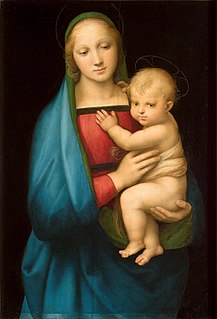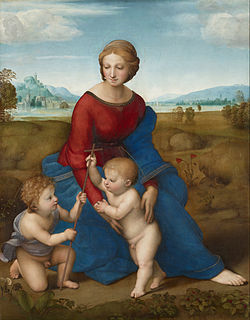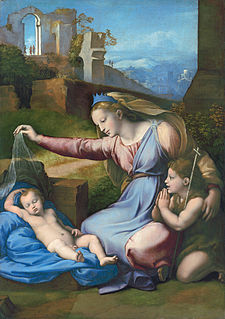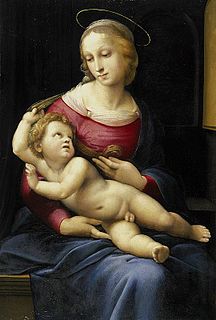
The Museum of Fine Arts is a museum in Heroes' Square, Budapest, Hungary, facing the Palace of Art.

Ridolfo di Domenico Bigordi, better known as Ridolfo Ghirlandaio was an Italian Renaissance painter active mainly in Florence. He was the son of Domenico Ghirlandaio.

The Madonna of Loreto is an oil on panel painting by the Italian High Renaissance painter Raphael, executed c. 1511. It is housed in the Musée Condé of Chantilly, France.

The Madonna of the Pinks is an early devotional painting usually attributed to Italian Renaissance master Raphael. It is painted in oils on fruitwood and now hangs in the National Gallery, London.

La Belle Jardinière, also known as the Madonna and Child with Saint John the Baptist, is a painting started by the Italian High Renaissance artist Raphael, and finished by Ridolfo del Ghirlandaio, that depicts the Madonna, a young Christ, and a young John the Baptist. It is believed to have been commissioned by the Sienese patrician Fabrizio Sergardi in approximately 1507. It is currently displayed in the Louvre Museum in Paris, France.

The Garvagh Madonna is an oil painting by the Italian Renaissance artist Raphael, dating to c. 1509–1510. It depicts the Virgin, the Christ Child and the infant John the Baptist, and is one of many paintings by Raphael with this trio. It is from early in the artist's third, or Roman period, in which distinctive changes are seen from his Umbrian or Florentine period in style and use of colour, with the introduction of more natural subjects and settings.

The Madonna del cardellino or Madonna of the Goldfinch is an oil on wood painting by the Italian Renaissance artist Raphael, from c. 1505–1506. A 10-year restoration process was completed in 2008, after which the painting was returned to its home at the Uffizi in Florence. During the restoration, an antique copy replaced the painting in the gallery.

The Madonna della Seggiola or The Madonna della Sedia is an oil on panel Madonna painting by the High Italian Renaissance artist Raphael, executed c. 1513–1514, and housed at the Palazzo Pitti Collection in Florence, Italy. Although there is documentation on its arrival to its current location, Palazzo Pitti, it is still unknown who commissioned the painting; however, it has been in the Medici family since the 16th century.

The Ansidei Madonna is a 1505–1507 painting by the Italian High Renaissance artist Raphael, painted during his Florentine period. It shows the Blessed Virgin Mary sitting on a wooden throne, with the child Christ on her lap. On her right John the Baptist stands, on her left Saint Nicholas is reading.

The Madonna del Granduca is a Madonna painting by the Italian renaissance artist Raphael. It was probably painted in 1505, shortly after Raphael had arrived in Florence. The influence of Leonardo da Vinci, whose works he got to know there, can be seen in the use of sfumato. The painting belonged to Ferdinand III, Grand Duke of Tuscany, from whom it got its name.

The Madonna del Prato, formally Madonna with the Christ Child and Saint John the Baptist, is an oil on board painting by Raphael, created in 1506, now held in the Kunsthistorisches Museum in Vienna. It is also known as the Madonna del Belvedere after its long residence in the imperial collection in the Vienna Belvedere.
Operation Budapest was a joint investigation between the Italian Carabinieri, the Hungarian police and the Greek police.

The Madonna with the Blue Diadem is a painting by Raphael and his pupil Gianfrancesco Penni, and was most likely painted in Rome around 1510-1512, now at the Louvre. In the Louvre, the painting is named Virgin and Child with the Infant Saint John, also known as Virgin with the Veil or Virgin with the Blue Diadem. Additional names include Virgin with the Linen, Slumbering Child and Silence of the Holy Virgin.

The Niccolini-Cowper Madonna, also known as the Large Cowper Madonna, is a painting by the Italian High Renaissance artist Raphael, depicting Mary and Child, against a blue sky.

The Small Cowper Madonna is a painting by the Italian High Renaissance artist Raphael, depicting Mary and Child, in a typical Italian countryside. It has been dated to around 1504–1505, the middle of the High Renaissance.

The Sistine Madonna, also called the Madonna di San Sisto, is an oil painting by the Italian artist Raphael. The painting was commissioned in 1512 by Pope Julius II for the church of San Sisto, Piacenza, and probably executed c. 1513–1514. The canvas was one of the last Madonnas painted by Raphael. Giorgio Vasari called it "a truly rare and extraordinary work".

Portrait of Pope Julius II is an oil painting of 1511–12 by the Italian High Renaissance painter Raphael. The portrait of Pope Julius II was unusual for its time and would carry a long influence on papal portraiture. From early in its life, it was specially hung at the pillars of the church of Santa Maria del Popolo, on the main route from the north into Rome, on feast and high holy days. Giorgio Vasari, writing long after Julius' death, said that "it was so lifelike and true it frightened everyone who saw it, as if it were the living man himself".
Marie von Augustin was an Austrian painter and writer. Some of her written work was published under her pseudonym, Marie von Thurnberg.

Madonna and Child with Saint Jerome and Saint Dorothy is a 1516 oil on canvas painting, now in the Kelvingrove Art Gallery and Museum in Glasgow, which purchased it from the McLellan collection in 1856. The Madonna's pose is based on that of Raphael's Esterhazy Madonna.

The Bridgewater Madonna is a religious painting by Raphael, dated 1507. Originally on oil and wood, but later transferred to canvas, it measures 81 by 55 cm. The picture is part of the permanent collection of the Scottish National Gallery in Edinburgh, on loan from the Duke of Sutherland Collection.


















